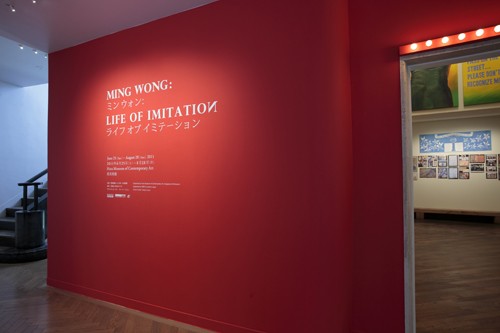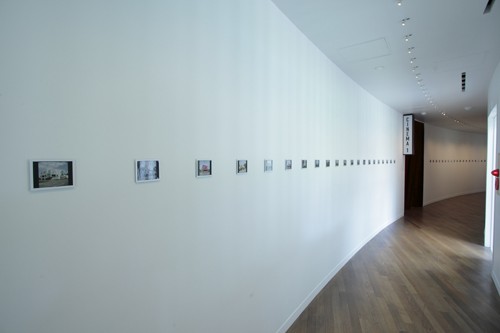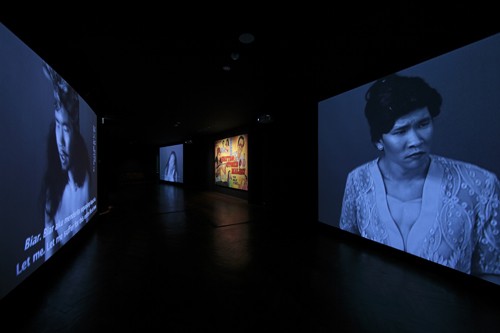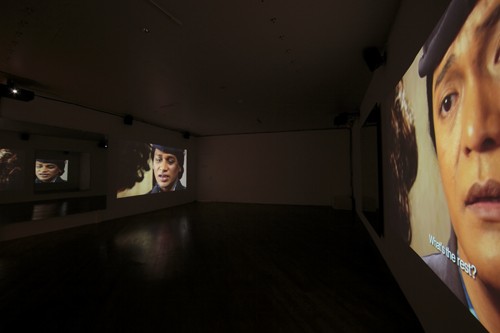From Hara Museum, Tokyo

Tan Fu Kuen:
Ming Wong’s work is about questioning “what is national cinema. “
In 1965, Singapore gained independence but it was the same year, ironically and sadly, that Singapore film industry totally collapsed. And by 1980s, for a period of 10 years, no film production happened. With the new government, the country became problematic in terms of how to become a nation, and how to reorganize language policies and racial relations. For example, Ming and I and those of us born in 1970s, we no longer studied Malay language in school. We were already very much separated from the 50s and 60s. For Ming Wong, using the tools of language and performance, and also with his investigation of history, he found a way to enter this period and re-look at some of the elements that made this period so unique.
Two important techniques he uses are the idea of parody (copying, imitation) and miscasting.

“Filem-Filem-Filem” 2009-2010
These polaroids are records of abandoned cinema building from the Golden Era. They were taken by Ming Wong on his investigation journey from Singapore to small towns in Malaysia, in search of Dream Palaces. Today they are abandoned, forgotten or used for non-cinematic functions like warehouse or car park. They are also in hodge podge of architectural styles – Bauhaus, art deco, some local binocular mix of what we call new international style — reflecting how urbanism entered 50s and 60s in Singapore.
Now from the artist.

“Four Malay Stories” 2005
Ming Wong:
“Four Malay Stories” was made in 2005 for the exhibition in Singapore. For this work I, together with my Malay friends in Singapore, watched many movies – or rather, I watched these Malay movies through their eyes and through their memories. We found scenes and lines that were iconic for the Malay community but that have now become controversial — what was good in the 50s and 60s, seen as taboo today – scenes of adultery, murder and alcoholism. I re-invented these scenes and lines because these movies are very hard to see today so a lot of the collected memory that we have disappeared. Hence I chose the most famous monochrome films in comedy, melodrama, film noir and historical epic. In the installation, characters talk to one another. You see how these characters come alive and interact with one another. I don’t speak Malay, so I use this film as a way to learn the language. I repeat and repeat the lines over and over again until I get the lines correct and also the acting becomes better. It’s my way of becoming Malay.

“In Love for the Mood” 2009
“In Love for the Mood” was inspired by Wong Kar Wai film “In the Mood for Love” from 2000. In this work, I use my strategies of miscasting and repetition, and the work is in the original language, Cantonese. I can speak Cantonese so I found an actress who could not speak Cantonese — a New Zealander actress who is based in Singapore. She has acted both as Maggie Cheung and Tony Leung. She had to speak her lines in Cantonese and I, as the director, feed her the lines off screen. She would repeat and repeat until she has got the lines correct. The scenes are presented in three screens. In the first screen, she is acting very well and her Cantonese is perfect. You would think “Ah, she speaks very good Cantonese”. Then you go to the second screen and the third screen, and her language is getting worse and the acting is also breaking down. Which means that in the editing process, I put all the best takes on the left screen (which is the conventional filming method), the the middle takes in the middle screen, and the worst takes on the last screen. And by breaking it down, you see the journey that the actress took,through repetition, to beome Cantonese.

“Life of Imitation” 2009
The third installation “Life of Imitation” in Cinema 3 was inspired by the 1958 Hollywood melodrama “Imitation of Life” by Douglas Sirk. It is a story of a black house keeper and her mixed-raced daughter, who looks white. The daughter wants to be an actress so she runs away from home and does not want people to know that her mother is black. If you were black in America in the 1950s, you did not get the same opportunities as a white person.
In this scene, the black house keeper was dying and wants to see her daughter for the last time. She found the daughter but daughter rejects her mother, saying “mommy, leave me alone! I’m white! I’m white!” She breaks down and the mother embraces her. But soon, the white friend of the daughter comes in and daughter has to pretend not to know her mother again. This is one of the first Hollywood films that dealt with the race issue. In my version, I use three actors in Singapore: Malay, Chinese and Indian actors, all men. They had to speak with an American accent. They take turn playing the mother, daughter and the daughter’s friend. When you see the installation there are two projections and two mirrors. With every shot, the actors change. Sometimes you see the Chinese actor being the black mother, sometimes it’s Indian actor playing the daughter — it keeps changing. On the two screens and the mirrors, actors seem to change from one to another.
Installation views at the Hara Museum of Contemporary Art
Photos by: Hirotaka Yonekura
*Collector Wong Han Min will give a talk at the museum on Sunday, July 31 from 1:00 pm. For more information please click here.
—————————————————
Please check here for Hara Museum access information
Ming Wong: Life of Imitation
-August 28, Sun
Now on sale. Yoshitmo Nara Charity Large-sized Postcard Set
Hara Museum is now participating in MuPon (museum discount ticket system using iPhone application)! http://www.tokyoartbeat.com/apps/mupon
Visit Hara Museum and Hara Museum ARC Twitter (in Japanese only) (account name: @haramuseum @HaraMuseumARC)
http://twitter.com/haramuseum
http://twitter.com/HaraMuseumARC
http://www.haramuseum.or.jp (museum website)
http://mobile.haramuseum.or.jp (mobile site)
